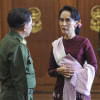Hunger gnaws at Rohingya children in camps

In the sweltering heat of Bangladesh's dusty Balukhali refugee camp, seven-month-old Mahmoud Rohan is burning up.
"I am worried about him," said his mother, 25-year-old Roshida Begum, in the waiting room of a malnutrition screening centre.
"He got a fever last night but I couldn't reach help. I was told to come here."
Along with an estimated 625,000 Rohingyas who have fled Myanmar for camps in Bangladesh since late August, Begum is struggling to feed herself and her baby.
The exodus began when coordinated Rohingya insurgent attacks sparked a ferocious military response, with the fleeing people accusing security forces of arson, killings and rape.
The top UN human rights official said on Tuesday that Myanmar's security forces may be guilty of genocide against the Rohingya.
Myanmar has rejected accusations of ethnic cleansing and has labeled Rohingya militants as terrorists.
While now safe from the threat of violence, refugees in Bangladesh now face malnutrition on an "alarming" scale, say aid agencies.
Health workers suspect tiny Mahmoud, who wears an oversized red sports shirt, has severe acute malnutrition - the most serious form of malnourishment. All he has had to eat in the camp, where his family has been for two months, is a few spoonfuls a day of rice mixed with sugar, his mother says.
At home in Maungdaw township in Myanmar's Rakhine state, Begum - who is unable to breastfeed properly - fed Mahmoud with rice water.
Now, as a health worker examines him, the circumference of his spindly upper arm indicates the severity of his condition.Around him, other mothers, some wearing black niqabs, sit on benches holding their babies in the small bamboo-walled centre.
Dressed in rags, eight-year-old Sadril Amin has brought his malnourished sister, 16-month-old Boila Amin, for a check up. Their mother is sick and their father is at the market, the little boy said through a translator.
VULNERABLE
Nearly a quarter of all the Rohingya refugee children in the Bangladeshi camps aged between six months and five years are malnourished, an analysis conducted by UNICEF found.
Compared to healthy youngsters, severely malnourished under-fives are nine times more likely to die from common infections.
Besides the visible effects on the body, such as muscle wasting, the condition leads to low immunity, meaning children become much more susceptible to other illnesses. The result is a toxic mix of health problems that can be fatal.
"If a child is malnourished, they can easily suffer from diarrhoea or pneumonia, and have to be referred to a hospital," said Charles Erik Haider, a doctor with the International Organization for Migration, in a clinic adjacent to the screening centre.
BANGLES
On the perilous journey to Bangladesh, most refugees survived on one meal a day or less, according to UNICEF. Stories abound of desperate people eating vegetation and drinking from puddles and streams.
Worse, it found around 7.5 per cent of all children – around 17,000 youngsters – are affected by severe acute malnutrition.
Children make up around 40 percent of the refugee influx, and are particularly vulnerable to starvation's effects.
"I had to drink water from a pool made by the monsoon rain," said Mohammad Hassim, 25, from his newly built hut on the other side of Balukhali camp.
He said he didn't eat for the final eight days of his arduous trek to Bangladesh, which included nearly three weeks hiding in the hills, and fell sick.

In the camps, food aid is being distributed by the Bangladeshi Army and World Food Programme - families are given rice, lentils and oil every fortnight - but many children are still struggling to eat properly.
Despite the dangers presented by malnutrition, many Rohingya mothers don't realise lack of nutritious food is the underlying health issue causing other illnesses in their children, said Haider, at the camp's clinic.
Often, parents will not realise the child is malnourished until they see a doctor for another reason. Many only know there is a problem when their babies' traditional bangles begin to slip from their skinny wrists.
"There is not much understanding of nutrition," said Haider. "We need to increase awareness around feeding. Education is the key."
Meanwhile, baby Mahmoud's condition is worrying the health workers, and he is referred to see Haider. His mother carries the baby the short distance to the clinic over a bamboo bridge, and is ushered inside.
"The child has a 103 F (39.4C) fever," Haider said. "It's very bad."
He makes a diagnosis of pneumonia and prescribes antibiotics for Mahmoud, with an instruction to return if there is no improvement. His mother simply nods and rocks Mahmoud as he cries on her knee.
She is also given Plumpy Nut - an emergency therapeutic food made from peanut paste - to feed her son.
For him, the future is uncertain. "With God's help he will get better," his mother said.

 For all latest news, follow The Daily Star's Google News channel.
For all latest news, follow The Daily Star's Google News channel. 








Comments